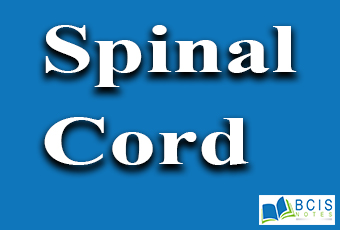
Spinal Cord:
Spinal Cord is a rope-like segment about the thickness of a pencil that connects nerves tissues extending down the back. It is a long, thin, tubular structure made up of nervous tissue, which extends from the medulla oblongata in the brainstem to the lumbar region of the vertebral column. It encloses the central canal of the spinal cord, which contains cerebrospinal fluid. Spinal cord lengths about 43cm in female and 45cm in man. It works as an information highway. It has basically three functions:
- Connects higher brain centres to and from and regulates reflexes e.g., hiccoughing, yawning, knee jerk, etc.
- Exchanges several messages between the brain and the body.
- Reflex action is an important function carried by a spinal cord.
Peripheral Nervous System:
The peripheral nervous system (PNS) is one of two components that make up the nervous system. It connects the outer portion of the body(periphery) with Central Nervous System (CNS). It is like the keyboard, monitor, and a printer that passes information in and out on a computer. It consists of 31 pairs of nerves and 12 pairs of cranial nerves. The PNS is not protected by the vertebral column and skull, or by the blood-brain barrier, which leaves it exposed to toxins and mechanical injuries. PNS is divided into the
The Somatic nervous system(SNS) and the Autonomous system(ANS).
The Somatic Nervous system(SNS):
The activities related to muscles that control the movement of the body are regulated by the somatic nervous system. It carries the information that receptors received from the environment to the spinal cord, brain and passes back the information to the brain. It is called the “Voluntary system” as all information passed is planned and by our will. Like when I write, my eyes scan the words and pick up the materials. Afferent nerves help to convey data to the CNS processes and formulate.
Autonomous Nervous system(ANS):
It derives its name because of its self-control nature of self-regulating and autonomous processes. This handles the bodily functioning of the heart, blood vessels, glands, lungs, etc. It works without our will and awareness and called the “Invoultary system”. It has two divisions like the Sympathetic divisions and the Parasympathetic system.
Sympathetic division:
It constitutes the fibers coming from the spinal cord in the thoracic and lumbar regions. It is active during our aroused state and prepares the body during emergency situation through ‘flight’ or ‘fight’. It does by increasing heart rate, sugar levels, and hormones to respond to the emergency situation. For example; when you see a cobra, then you will be frightened and your sympathetic system raises and increases the blood levels and keeps you in calm condition quickly.
Parasympathetic division:
It falls into two parts: the cranial and the sacral region that is above and below the sympathetic division. It works to store the body’s energy. It slows the processes accelerated by the sympathetic system. It tends to be active when we are calm and relaxed during our daily routine.
The Endocrine Glands:
- Pituitary gland – Called the “master glands” as it has control over all the glands. It secretes the growth hormone called ‘somatotropin’.
- Thyroid gland – secrets ‘thyroxin’ to regulate oxygen consumption.
- Parathyroid gland – secrets ‘parathormone’ to regulate the calcium level in a body.
- Adrenal gland – secrets hormone called ‘cortin’.
- Gonads – is sex glands. In males, ‘testosterone’ and ‘androsterone’ hormones are secreted and in females, ‘estrogen’ and ‘progestin’ hormones are secreted.
You may also like Sensory processes

Leave a Reply